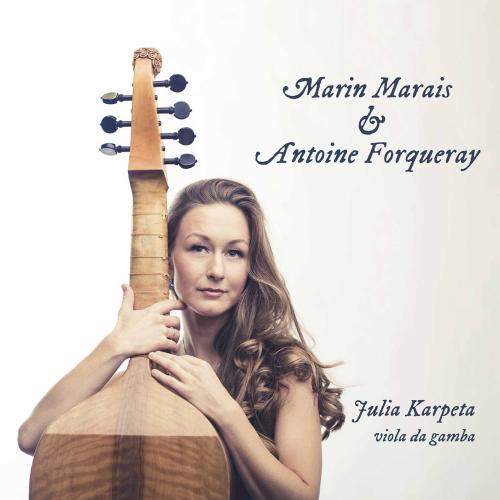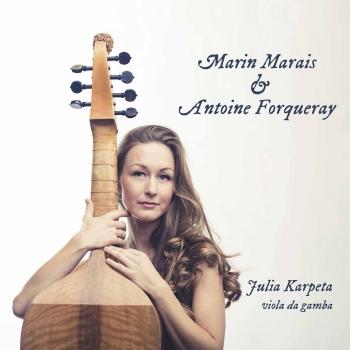
Marais & Forqueray: Chamber Works Julia Karpeta
Album Info
Album Veröffentlichung:
2019
HRA-Veröffentlichung:
08.11.2019
Label: CD Accord
Genre: Classical
Subgenre: Chamber Music
Interpret: Julia Karpeta
Komponist: Antoine Forqueray (1672-1745), Marin Marais (1656-1728)
Das Album enthält Albumcover Booklet (PDF)
- Marin Marais (1656 - 1728): Pièces de viole, Book 5 (Excerpts):
- 1 Pièces de viole, Book 5 (Excerpts): No. 1, Prélude le Soligni 01:45
- 2 Pièces de viole, Book 5 (Excerpts): No. 2, Allemande la facile 01:25
- 3 Pièces de viole, Book 5 (Excerpts): No. 3, Sarabande 02:51
- 4 Pièces de viole, Book 5 (Excerpts): No. 4, La mariée 01:15
- 5 Pièces de viole, Book 5 (Excerpts): No. 7, Minuet & Double 01:26
- 6 Pièces de viole, Book 5 (Excerpts): No. 15, Rondeau moitié pincé 02:43
- Antoine Forqueray (1672 - 1745): Pieces de viole, Suite No. 1 in D Minor:
- 7 Pieces de viole, Suite No. 1 in D Minor: VI. La couperin (Arr. for Viola da gamba, Theorbo & Harpsichord) 04:12
- Marin Marais: Pièces de viole, Book 3 (Excerpts):
- 8 Pièces de viole, Book 3 (Excerpts): No. 40, Prélude 01:16
- 9 Pièces de viole, Book 3 (Excerpts): No. 41, Fantaisie 00:42
- 10 Pièces de viole, Book 3 (Excerpts): No. 42, Allemande 02:16
- 11 Pièces de viole, Book 3 (Excerpts): No. 43, Courante 01:23
- 12 Pièces de viole, Book 3 (Excerpts): No. 44, Sarabande 02:45
- 13 Pièces de viole, Book 3 (Excerpts): No. 46, Gigue 01:00
- 14 Pièces de viole, Book 3 (Excerpts): No. 54, Rondeau 03:18
- 15 Pièces de viole, Book 3 (Excerpts): No. 55, Plainte 03:51
- 16 Pièces de viole, Book 3 (Excerpts): No. 56, Chaconne 02:34
- Antoine Forqueray: Pieces de viole, Suite No. 2 in G Major:
- 17 Pieces de viole, Suite No. 2 in G Major: IV. La leclair 03:46
- Marin Marais: Pièces de viole, Book 4 (Excerpts):
- 18 Pièces de viole, Book 4 (Excerpts): No. 23, Prélude 02:49
- 19 Pièces de viole, Book 4 (Excerpts): No. 25, Gavotte 01:25
- 20 Pièces de viole, Book 4 (Excerpts): No. 27, Caprice 01:00
- 21 Pièces de viole, Book 4 (Excerpts): No. 28, Musette I - No. 29, Musette II 02:45
- 22 Pièces de viole, Book 4 (Excerpts): No. 30, La sautillante 01:10
- Antoine Forqueray: Pieces de viole, Suite No. 2 in G Major:
- 23 Pieces de viole, Suite No. 2 in G Major: V. Chaconne. La buisson (Arr. for Viola da gamba & Theorbo) 05:13
Info zu Marais & Forqueray: Chamber Works
Marais’ works included in this recording are taken from three different collections. In each case, according to the performance practice of that time, musicians themselves decided about the final sound shape by choosing the parts and line-up of the continuo. Chronologically the oldest work among these included in the recording is the Suite in D major, chosen from the third volume of Pièces de viole (1711). Its style can be described as conservative and, as far as textural and harmonic solutions are concerned, is rooted in the musical language of Lully’s operas. The choice of parts suggested by the performers is also an expression of their tribute to tradition – the central position is taken by “classic(al)” four dances (allemande, courante, sarabande, gigue) supplemented by a slow prelude (Prélude), which is figured slightly in the Italian style of Fantaisie, nostalgic Plainte, airy Rondeau and elaborate Chaconne. Musicians interpreted the Suite in A minor from the fourth volume of Pièces de viole (1717) in a different way and highlighted its parts with a light and rustical character – a playful Gavotte and Muzettes are here as well as a lively miniature with a suggestive title La Sautillante, and the whole is opened with the Prélude, expressive and full of dissonant harmonies. On the other hand, the Suite in A minor from the fifth volume of Pièces de viole (1725) contains movements which are pathetic and melancholic at the same time. The work is opened with a celebratory Prélude, full of rhetorical leaps and numerous dissonances, which brings to mind operatic rècit or solemn, funerary tombeau. The short and airy Allemande la Facile (easy), that apperas later, leads to a Sarabande characterised by a noble pathos. The monumental and brooding mood reappears in the miniature La Mariée (a married woman), in a pair of minuets as well as in the Rondeau, which closes the work.
A peculiar counterpoint to subtle works of Marais is provided by three miniatures by Forqueray presented on the disc. (...)
The first piece of the recorded ones – the miniature La Couperin – is a musical portrait of one of the members of the famous musical family. A pathetic character of this piece, full of rhetoric interval leaps and dissonances, allows us to suppose that it was composed as a tombeau, perhaps even dedicated to the memory of François Couperin. There is no doubt in the case of the second miniature La Leclair, which clearly refers to the musical style of one of the greatest French violinists from the first part of the 18th century, Jean-Marie Leclair (1697–1764), by the way, a great dancer. The third presented miniature La Buisson is the most enigmatic. On the one hand, its form refers directly to the style of monumental, operatic chaconnes, on the other hand, the composer gave it a title difficult to interpret clearly, which can be translated as a “bush”. Whether it referred to the parts with unusual kinds of figuration, like thorns irritating the ears of listeners from those time, or to the person of Pierre Buisson, the composer’s brother-in-law and at the same time his son’s best man when he married Marie Roze Dubois, it is hard to state unequivocally.
Julia Karpeta, viola da gamba
Julia Karpeta
She graduated from the viola da gamba class of the Secondary Music School in Wrocław, where she studied with Prof. Petr Wagner. She mastered her skills at the University of North Carolina at Chapel Hill, collaborating with Prof. Brent Wissick and next with Rainer Zipperling in Cologne. Julia studied also with the English gambist Mark Caudle. The history of her studies includes also the masterclasses with Paolo Pandolfo, Wieland Kuijken and Lucas Peres. As a soloist and chamber player she performs in Poland and abroad (Germany, Italy, Croatia, Lithuania, Finland and Spain). She regularly collaborates with a number of superb early music ensembles. Julia has participated inseveral early music festivals, among others International Festival Wratislavia Cantans, Ludwig van Beethoven Easter Festival, BRQ Vantaa Festival, MITTO SettembreMusica, Misteria Paschalia, Intenational Bach Festival in Świdnica, Pieśń Naszych Korzeni and Festival International de Santander. Her cooperations with other musicians include a bulk of CD recordings (Musica Gratulatoria with Ars Cantus, albums with pieces by Polish composers Marcin Mielczewski and Bartłomiej Pękiel with Wrocław Baroque Ensemble and others). She recorded for MEZZO TV playing with ensembles Arte dei Suonatori and Le Poème Harmonique. In 2011 she became a fellow of the „Young Poland” – Programme of the Minister of Culture and National Heritage. With her husband, she plays in a viola da gamba duet Fernabucco, winner of the 2nd prize at the International Early Music Competition in Żory 2012. She also cocreates the Overtone trio who specialise in the performance of 17th and 18th century music. Artist besids viola da gamba plays also soprano viol and violone in G.
Booklet für Marais & Forqueray: Chamber Works










